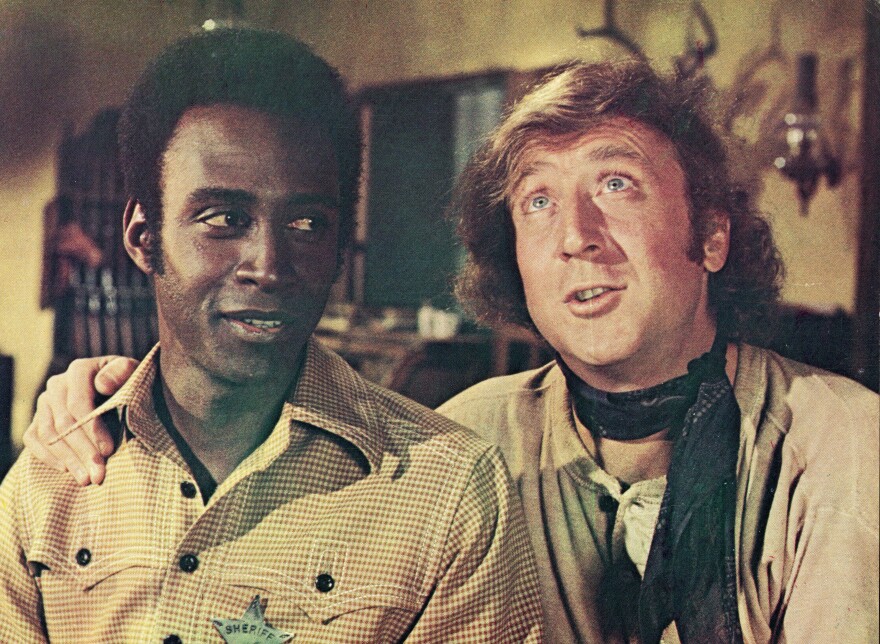Fifty years ago, Mel Brooks released Blazing Saddles to gales of laughter and a mighty roar of flatulence jokes.
Also to mixed reviews from harrumphing critics. Typicalwas Vincent Canby, whose New York Times review lamented the film's "desperate, bone crushing efforts to be funny."
The critics eventually came around, though it took a while. By the film's 30th anniversary, NBC's Today Show was acknowledgingthat its laughs were in the service of a plot that "skewers just about every aspect of racial prejudice."
And in 2006, when NPR's Linda Wertheimer reported that Blazing Saddles was being added to the National Film Registry, she was clearly feigning incredulity. "Who could have imagined a film featuring a bunch of cowboys sitting around the campfire, eating beans and breaking wind, to be enshrined in the Library of Congress?"
By then, of course, everyone could imagine. Brooks had subsequently made a slew of genre-spoof classics (Young Frankenstein, Silent Movie, High Anxiety, Spaceballs, Robin Hood: Men in Tights) and even riffed on history itself (History of the World: Part I), not to mention the 2000 Year Old Man routines he created with Carl Reiner. The man was a legend.
But in 1974, he was significantly less well-known, having made a couple of mildly successful comedies (The Twelve Chairs and The Producers) and worked inSid Caesar's joke-writer stable for TV. So what he was doing in this western parody got, in the words of another of that era's funnymen, "no respect."
Upending Hollywood's version of the Old West
Blazing Saddles starts out like many a Western before it: Big Sky country, a wide open prairie in the 1870s being tamed by a railroad. The foreman is white, his workers mostly African American, and he expects them to be singing as they sweat.
"When you were slaves you sang like birds," he smirks. "How about a good ol' n***** work song."
Brooks worried about using the racial epithet I've just elided. But his co-screenwriter Richard Pryor insisted he use it — and use it often — consciously putting it the mouths of evil or unthinking characters, so that star Cleavon Little could comically mock or demolish them.
Which he does. Repeatedly. And hilariously.
So, Blazing Saddles is not really "like many a Western before it." Brooks was upending Hollywood's version of the Old West, much as Robert Altman's dark, land-grab drama McCabe & Mrs. Miller had, three years earlier. He just took a different tack. To set his comedy in motion, he had Harvey Korman's scheming politician come up with the idea of hiring a Black sheriff to scare the townsfolk of Rock Ridge away from their town, so he can buy it on the cheap before any of them learns the rail line will soon be coming through.
His ploy works. When Cleavon Little's Sheriff Bart rides into view, they are indeed less than welcoming. But they are also less than bright – foiled in their plan to shoot their new sheriff, for instance, when he points his gun at his own head and takes himself hostage.
'He's like wet sauerkraut in my hands'
Bart then teams up with Gene Wilder's Waco Kid, a hung-over gunslinger, at which point the film adopts the rhythms of a black/white buddy comedy. Until, that is, it turns into a spoof of The Blue Angel, as Madeline Kahn's seductress-for-hire Lili Von Shtupp croons a gloriously off-pitch "I'm Tired" and sets about seducing Sheriff Bart. "He's like wet sauerkraut in my hands," she purrs in an accent that suggests she got vocal coaching from both Marlene Dietrich and Elmer Fudd.
To satirize 1970s racial prejudice using 1870s characters, Brooks opted to become an equal-opportunity shredder of genres and conventions. A horse gets punched, as does an old lady. Even Busby Berkeley musicals come in for a brief ribbing when a brawl literally breaks the fourth wall and the cast crashes into a dance number on a nearby soundstage.
And of course, there's that campfire scene: cowboys consuming pots of coffee and platefuls of baked beans, with predictable — though unusual for film — results.
'Bury it.'
When studio executives first saw Blazing Saddles, they were not amused. One distributor suggestedthey "bury it." Others wanted rewrites. But Brooks' contract gave him final cut, and he flat-out refused to make changes.
So on Feb. 7, 1974, the studio opened the film as a test in three cities — NYC, LA, Chicago — considered the most likely to get Brooks' Borscht Belt sense of humor. Critics were dismissive, but even the most negative reviews conceded that audiences were howling.
And word got around. By the time the weather had warmed, Blazing Saddles was playing to long lines in suburban cinemas across the country.
It ended up the biggest box-office hit of 1974, seen by some 63 million moviegoers in North America (more than would, decades later, see any of the Lord of the Rings movies in U.S. theaters).
Blazing Saddles became, in short, a pop culture touchstone. And 50 years later, that's what it remains.
Copyright 2024 NPR. To see more, visit https://www.npr.org.



